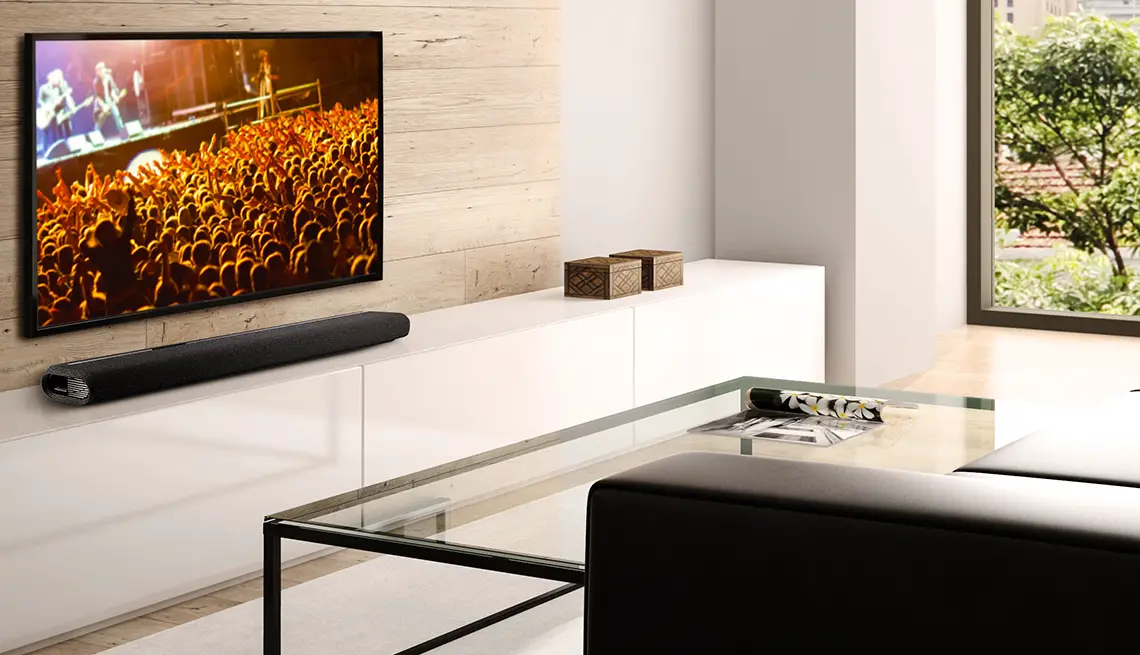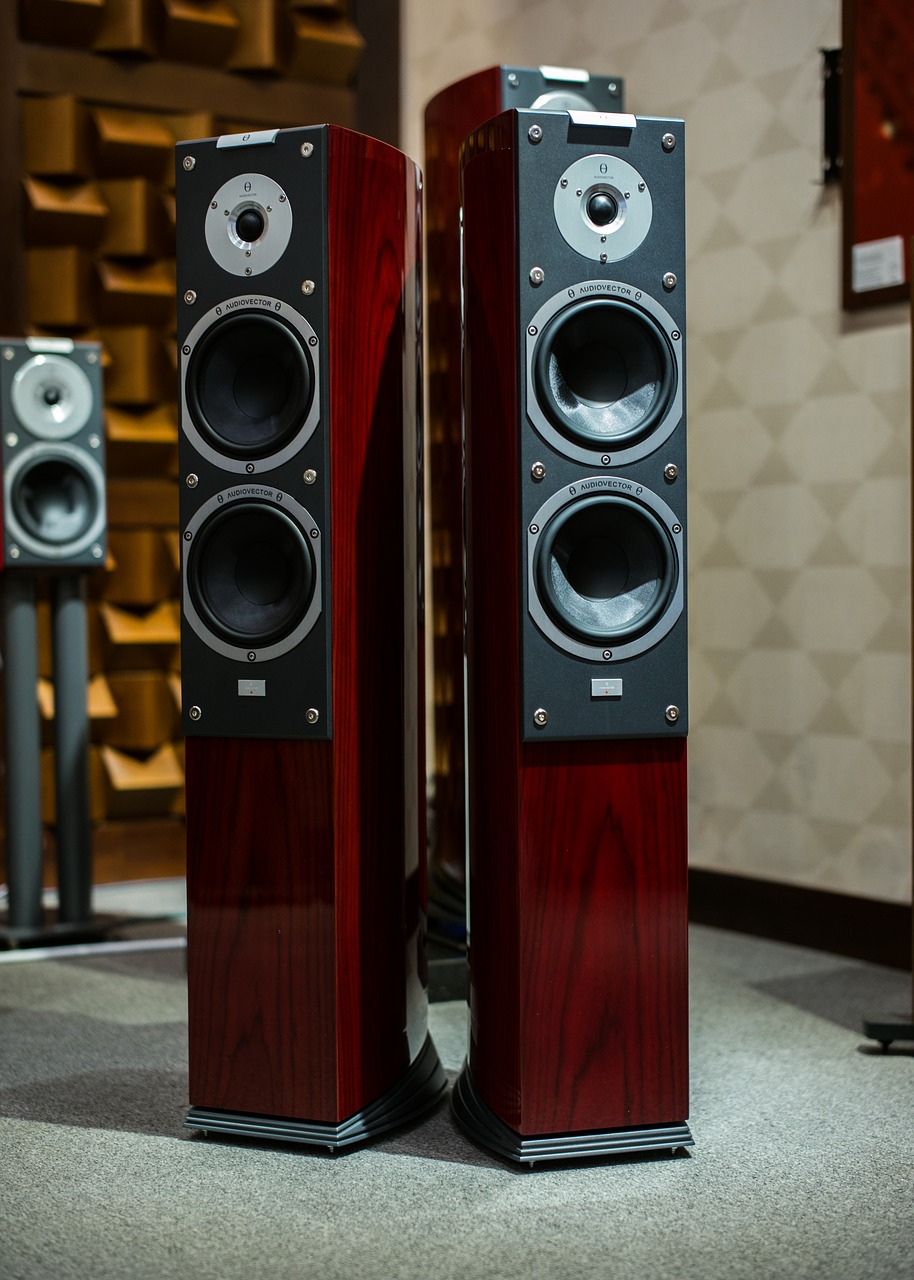
Soundbar vs Bookshelf Speakers
If you consider yourself an audiophile, you may be wondering what the advantages of a soundbar are over a pair of quality bookshelf speakers (which would sound better). The answer is that depending on your room size and personal tastes, a soundbar can be better.
Most people who are getting into home theater have smaller rooms for the first time, and the number one reason they don’t go with a good pair of bookshelf speakers is that they don’t want to deal with positioning them correctly. You don’t have to worry about this with a soundbar because it does all the work for you.
You should be aware that there are a few downsides to soundbars, however. They won’t sound as good as a good pair of bookshelf speakers in certain situations, and they can easily take up more space than a pair of bookshelf speakers while also requiring more power.
If you have space concerns, bookshelf speakers may be a better option for you. Soundbars can also be more challenging to set up correctly than bookshelf speakers. You may need a special receiver or amp with a soundbar, whereas you could plug your bookshelf speakers into an existing receiver.
On the other hand, if you are looking for a quick and easy solution that will be ready to go right out of the box, the Soundbar may be the way to go. Many great soundbars sound amazing. Also, if you want a wireless speaker that is easy to move around, a soundbar is not a bad choice. You can quickly grab one and take it to another room or bring it outside if you want. If your space is limited, this could be the way to go.
We will dig deeper into the Soundbar vs Bookshelf Speakers debate to help you get to a definitive answer. Let’s start with Soundbars.
Soundbar

A soundbar is a long, thin speaker that sits under or beside your TV. It typically has one main driver on the bottom and a few tweeters up top. It’ll also have a subwoofer — which makes it a soundbar — to give your bass frequencies. You can think of it like a bookshelf speaker that you mount above or below your TV. But instead of having to place multiple speakers around your room, and run the wire to connect them, a single soundbar can do the same thing with much less hassle and expense.
Soundbars are also known as soundbases. They usually have a rectangular enclosure that sits directly below the TV, with the driver facing upwards and the tweeters facing towards you. Some soundbars even have wireless subwoofers for truly wireless surround sound.
Soundbars are inexpensive, easy to set up, and usually offer remote control for adjusting the volume and bass (and sometimes treble). They also generally have a built-in digital-to-analogue converter (DAC) to handle the audio signal’s decoding and processing. More on DAC later.
The sound quality can be excellent — especially if you stick with a reputable brand and the Soundbar has a decent-sized driver. Soundbars are an excellent alternative to a full surround sound system if you don’t want to spend the money or hassle. But some people find them too big or bulky, especially if they don’t have a lot of space below their TV set.
Soundbar Sound Quality
Most soundbars have a two-way system: one driver to handle the highs and another driver to handle the lows. The tweeters are usually located on the top and facing towards you. The woofers are usually on the bottom, facing downwards (like most bookshelf speakers).
Some soundbars have three-way systems with tweeters, woofers and passive radiators. These soundbars will usually have a subwoofer, as well.
The Soundbar’s quality of sound will depend on the brand and model that you buy. Some brands are well-known for their audio quality. Some brands also include a digital-to-analogue converter (DAC) inside each channel of their speaker system.
This means that they can do the audio processing internally, instead of relying on your TV or receiver to do all the work for them, improving audio quality by an extra few dB. If you’re looking to buy a soundbar, make sure to check out its specifications before you buy it. That way you’ll know what kind of audio quality you’re getting for your hard-earned money.
What is DAC, and does it matter?
A digital-to-analogue converter, or DAC, does the opposite of what an amplifier does. Instead of taking an analogue signal and amplifying it, a DAC takes a digital signal and converts it into an analogue signal.
DACs are useful because they allow you to use a single digital source to power multiple audio systems at once. For example, you could have a digital source like a TV or a computer powering several different speakers in your home. Instead of connecting each speaker to its amplifier, you can connect all your speakers to a single one. This will save you space and money while still giving you the best possible audio quality.
Some DACs can also process the audio signal before it is sent to the amplifier. Some DACs include settings for bass and treble control, while others can also include dynamic range compression settings. A DAC with these extra features can improve the sound quality even more than just using an amplifier with volume control built-in.
DACs are very common in modern audio systems. Most computers and modern receivers have DACs built into them already. This means that they can send digital audio to a receiver or Soundbar without converting anything first. If you’re looking for a new soundbar, try to check how many channels it has on its back panel (this will usually be written on the specifications or description page). The more channels there are, the better your sound will be — especially if you use them all at once!
Let’s take a look at the other side of our Soundbar vs Bookshelf Speakers debate.
Bookshelf Speakers

Bookshelf speakers are small, stand-alone speakers that usually don’t have a subwoofer. They are traditionally a 2-way speaker system with the tweeter and the woofer firing out of the speaker’s front, facing you.
Bookshelf speakers are typically placed on a shelf or side table, facing towards you. They can also be placed on a floor stand or mounted on the wall behind your TV set. A typical bookshelf speaker set is a 2-way speaker set. Typically, this includes a tweeter and a woofer. The tweeter is on top; the woofer is on the bottom. There may also be a passive radiator (or two) to help with bass response.
Bookshelf speakers are usually more expensive than soundbars but offer better sound quality. They have a wider frequency response range, more dynamic range and usually have larger drivers and tweeters, which will give you a much better sound. Bookshelf speakers are also easier to place around your room and often look better than the long, thin Soundbar.
Bookshelf speakers are a great choice if you are looking for an authentic surround sound experience with a better audio system. They are also a good choice if you want to upgrade your home theatre system, or if you want to try something more powerful.
Bookshelf Speakers Sound Quality
The quality of the sound coming out of your speakers will depend on the technology they are using:
Passive Radiators
Passive radiators are typically found in 2-way systems. They’re just long cylinders that help with bass response. Passive radiators do not have a magnet or moving parts, and therefore do not produce any sound independently. They vibrate in response to the sound from the woofer (i.e. when you play low frequencies, the passive radiator will start vibrating). Passive radiators are sometimes used when a speaker enclosure is empty, or there is no other way to get bass response from a 2-way speaker system.
Active Radiators
Active radiators are similar to passive radiators, but they have electromagnets that vibrate in response to the sound coming from the woofer. This means that active radiators will vibrate even if there is no input signal coming through the amplifier. This may make them seem louder than passive radiators. Active radiators are only found in 2-way speaker systems. They are not very common.
Usually, when you see active radiators, it’s because a speaker system is trying to have bass response from a 2-way system and there is no way to get bass out of it without adding active radiators. A few 3-way speaker systems use active radiators for all 3 of their drivers (i.e. tweeter, midrange and woofer). But most 3-way speaker systems use passive radiators for all three drivers.
Soundbar vs Bookshelf Speakers: Which Is Better?
Bookshelf speakers have better sound quality than soundbars, but they are much more expensive and harder to set up. They are not ideal for someone who wants a simple set up that will work well for music and movies. Soundbars are much easier to set up than bookshelf speakers — especially if you set them up on your own!
If you have problems setting up your bookshelf system, you might want to consider getting a soundbar instead. But if you’re willing to spend some time and money on your setup, then bookshelf speakers might be a better option for you!
I hope we have helped you with a decision in the Soundbar vs Bookshelf Speakers match up. After all of this, are you still interested in Bookshelf speakers? Check out our Best Bookshelf Speakers under $300. Otherwise, we have reviewed the Best Soundbar under $200.
